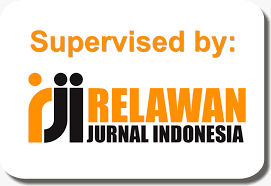Pengaruh Gaya Kepemimpinan dan Motivasi terhadap Kinerja Karyawan PT PLN (Persero) UIP SUMBAGSEL
DOI:
https://doi.org/10.52333/strategi.v15i1.1244Abstract
Abstract : This study aims to determine the influence of independent variables including Leadership Style (X1), and Motivation (X2) simultaneously and partially affect the Employee Performance variable (Y) significantly. The method of data collection used in the study was by distributing questionnaires to employees at the PT. PLN (Persero) UIP Sumbagsel office. The population is all employees in the finance and HR fields at PT. PLN (Persero) UIP Sumbagsel totaling 35 people. The sampling technique in this study is a saturated sample, namely where all populations are used as samples for distributing questionnaires. The results of this study indicate the results of multiple linear analysis as follows: Y = 16.849 + 2.238X1 +0.416X2 the value of 16.849 is the Constant value (Y), the value of 2.238 is the coefficient of the Leadership Style variable (X1), the value of 0.416 Motivation (X2). Based on the results of the correlation test, it is known that the correlation value between the variables of Leadership Style, and Motivation with the variable Employee Performance is 0.925. This figure indicates that there is a strong correlation between the variables of Leadership Style, and Motivation with the variable Employee Performance with a significance level of 0.000 <0.05. Based on the results of the study conducted, the magnitude of the correlation coefficient (R2) is 0.885 (85.5%). This means that Leadership Style and Motivation affect Employee Performance by 0.885 or 85.5%, while the remaining 15.5% is influenced by other variables not examined in this study. Based on the F test, the F count is 60.886 with a significance level of 0.000. Therefore, the significance value is much smaller than () 0.05, it can be stated that the independent variables including Leadership Style (X1), and Motivation (X2) simultaneously or together affect the variable Employee Performance (Y) significantly. Based on the results of the t-test on the first hypothesis, the t-value on the Leadership Style variable (X1) is 4.741 with a significance level of 0.000. Because the significance is 0.000 < () 0.05, H0 is rejected and H1 is accepted, which means that the Leadership Style variable has a significant effect on Employee Performance (Y). And based on the results of the t-test on the second hypothesis, the t-value on the Motivation variable (X2) is 6.669 with a significance level of 0.000. Because the significance is 0.000 < () 0.05, H0 is rejected and H1 is accepted, which means that the Motivation variable has a significant effect on Employee Performance (Y).
Abstrak : Penelitian ini bertujuan untuk mengetahui pengaruh variabel independen yang meliputi Gaya Kepemimpinan(X1), dan Motivasi (X2) secara simultan dan parsial mempengaruhi variabel Kinerja Karyawan (Y) secara signifikan. Metode dalam pengumpulan data yang digunakan dalam penelitian adalah dengan membagikan kuisioner kepda para pegawai yang ada di kantor PT. PLN (Persero) UIP Sumbagsel. populasi adalah seluruh karyawan bidang keuangan dan SDM di PT. PLN (Persero) UIP Sumbagsel sejumlah 35 orang. Teknik pengambilan sampel dalam penelitian ini merupakan sampel jenuh yaitu dimana semua populasi dijadikan sebagai sampel untuk penyebaran kuisioner. Dari hasil penelitian ini menunjukkan adanya hasil analisis linear berganda sebagai berikut: Y = 16,849 + 2,238X1 +0, 416X2 nilai sebesar 16,849 adalah nilai Konstanta (Y), nilai sebesar 2,238 adalah koefisien variabel Gaya Kepemimpinan(X1), nilai sebesar 0,416 Motivasi(X2). Berdasarkan hasil uji korelasi diketahui bahwa nilai korelasi antara variabel Gaya Kepemimpinan, dan Motivasi dengan variabel Kinerja Karyawan sebesar 0,925 angka tersebut menunjukkan bahwa terdapat korelasi yang kuat antara variabel Gaya Kepemimpinan, dan Motivasi dengan variabel Kinerja Karyawan dengan tingkat signifikan 0,000 <0,05. Berdasarkan hasil penelitian yang dilakukan menunjukkan besarnya koefisien korelasi (R2) sebesar 0,885 (85,5%). Ini berarti Gaya Kepemimpinan dan Motivasi berpengaruh terhadap Kinerja Karyawan sebesar 0,885 atau 85,5%, sedangkan sisanya 15,5% dipengaruhi oleh variabel lain yang tidak diteliti dalam penelitian ini. Berdasarkan uji F menunjukkan Fhitung sebesar 60,886 dengan tingkat signifikansi 0,000. Oleh karena nilai signifikansi jauh lebih kecil daripada () 0,05 maka dapat dinyatakan bahwa variabel independen yang meliputi Gaya Kepemimpinan(X1), dan Motivasi (X2) secara simultan atau bersama-sama mempengaruhi variabel Kinerja Karyawan (Y) secara signifikan. Berdasarkan hasil uji t pada hipotesis pertama yaitu nilai thitung pada variabel Gaya Kepemimpinan (X1) adalah sebesar 4,741 dengan tingkat signifkan sebesar 0,000. Karena signifikansinya 0,000 < () 0,05 maka H0ditolak dan H1diterima, yang berarti variabel Gaya Kepemimpinan berpengaruh signifikan terhadap Kinerja Karyawan (Y). Dan berdasarkan hasil uji t pada hipotesis kedua yaitu nilai thitung pada variabel Motivasi (X2) adalah sebesar 6,669 dengan tingkat signifikan sebesar 0,000. Karena signifikansinya 0,000< () 0,05 maka H0 ditolak dan H1 diterima, yang berarti variabel Motivasi berpengaruh signifikan terhadap Kinerja Karyawan (Y).
References
AA, Anwar Prabu Mangkunegara. 2017. Manajemen Sumber Daya Manusia Perusahaan. Bandung: PT. Remaja Rosdakarya.
Afrizal. 2014. Metode Penelitian Kualitatif. Cetakan 1, PT Raja Grafindo Persada, Jakarta.
Erni Tisnawati dan Donni Juni Priansa. 2018. Kepemimpinan dan Perilaku Organisasi. Cetakan I, PT Refika Aditama, Bandung.
Emron Edison,Dkk. 2018. Manajemen Sumber Daya Manausia Cetakan 3, Alfabeta, Bandung.
Gary Dessler. 2015. Manajemen Sumber Daya Manusia. Edisi 14, PT. Salemba Embat Patria, Jakarta.
IrhamFahmi. 2017. Manajemen Sumber Daya Manusia. Cetakan 2, Alfabeta, Bandung.
Nur Indriantoro dan Bambang Supomo. 2014. Metode Penelitian Bisnis Untuk Akuntansi & Manajemen. Edisi 1, BPFE-YOGYAKARTA.
Rivai Veitzhal, Bachtiar & Boy. 2013. Pemimpin dan Kepemimpinan Dalam Organisasi. Jakarta: PT. Raja Grafindo Persada.
Rivai Veitzhal, Muliaman & Mansyur. 2014. Kepemimpinan dan Perilaku Organisasi. Jakarta: PT. Raja Grafindo Persada.
S.P, Hasibuan, Malayu. 2015. Manajemen Sumber Daya Manusia. Edisi Revisi, Jakarta: PT. BumiAksara.
Sugiyono. 2015. Metode Penelitian Bisnis. Cetakan 4, Alfabeta, Bandung.
Thoha, Miftah. 2015. Kepemimpinan Dalam Manajemen. Cetakan 18, PT. Raja Grafindo, Jakarta
Zulganef. 2018. Metode Penelitian Bisnis dan Manajemen. Cetakan 1, PT Refika Aditama, Bandung.
Downloads
Published
How to Cite
Issue
Section
License
Copyright (c) 2025 Hasyunah, Syahyuni, Ricardo

This work is licensed under a Creative Commons Attribution-NonCommercial-ShareAlike 4.0 International License.






